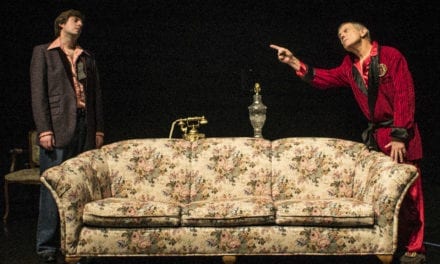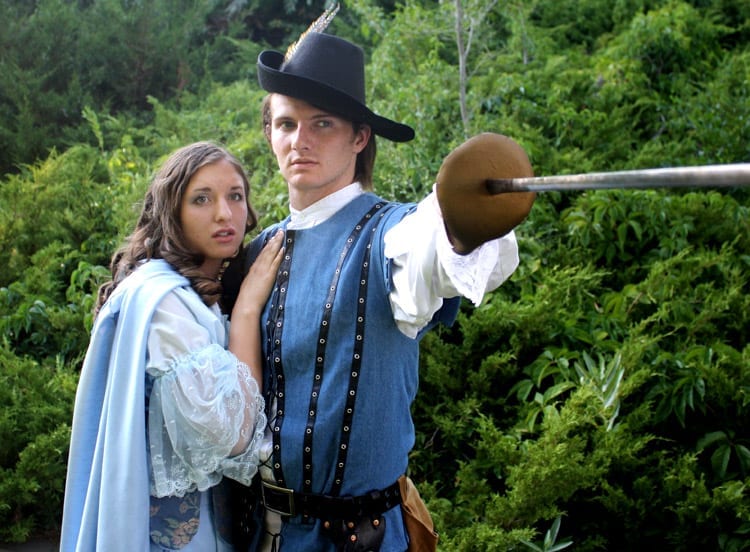OREM — SCERA’s production of Spamalot is so side splitting that describing it exhausts the English language’s supply of words that mean “funny.” Even the best thesaurus is inadequate to the task.

Show closes May 8, 2021.
Spamalot is the stage musical adaptation of one of the funniest films ever made, Monty Python and the Holy Grail. The play and the film are both a spoof of the tale of King Arthur’s quest for the holy grail. Eric Idle‘s script retains the most memorable bits from the movie, including Dennis and his commentary on monarchy, the Holy Hand Grenade, and the Knights Who Say “Ni!” But Idle was willing to depart from the source material often enough for Spamalot to be its own work of art. The new role of the Lady of the Lake, a different ending to the rescue scene, and a strong score (with music by John Du Prez and Eric Idle and lyrics by Idle) of hysterical songs. The SCERA produced the “School Edition,” which is a shorter version (two hours, including the 15-minute intermission) of the script that eliminated the crassest humor and focused the show.

Left to right: BJ Oldroyd as King Arthur, A.J. Nielsen as Patsy, and Allison Books as the Lady of the Lake. Photo by Rachael Gibson.
Not that the adult actors needed much help to make the play work. This cast is one of the most talented collection of performers I have seen in recent memory, with every actor oozing charisma and flair. The ensemble, supporting performers, and leads worked as a harmonious whole that was greater than the sum of its parts. As the cowardly Sir Robin, Jake Hart delighted me with his flip-flop between chivalrous knight and terrified ninny, especially when he was scared off by the Knights Who Say “Ni!” Keegan Briggs paid homage to the famous “I’m not dead yet!” scene while making it his own when it turned into a musical number.
The standout performer, though, was Allison Books as the Lady of the Lake. Books has a divine voice, and she pours passion and power into every note of her songs. Books does not just have the vocal power to handle the role, though. She understands how to act the songs so that the humor takes precedence. Her exasperation in “Whatever Happened to My Part?” and the commitment to the cheesiness of “The Song That Goes Like This” made both of the songs some of the most humorous moments in a show brimming with hilarity. It is amazing that Books has such a strong handle on torch songs that she can perform two parodies of them without being repetitive in her performance.

Allison Books as the Lady of the Lake. Photo by Rachael Gibson.
Heading this zany cast is BJ Oldroyd as King Arthur. Oldroyd’s character is the “straight man” in the show who sets up many of the gags for the other actors. Oldroyd plays this well, having a stoic, serious demeanor—even while performing corny dances in “Knights of the Round Table.” The stability and soberness of King Arthur contrasted with the lunacy of all the other characters, which made their antics seem even more bizarre. “Find Your Grail” became even more ridiculous when all the other performers were making a farce of the song by getting too caught up in it . . . and Arthur was treating it as a serious call to action.
This is an example of the genius of Michael Carrasco‘s direction. Carrasco knows how to blend the serious and the silly in the perfect proportion to maximize the humor in a scene. He does not overuse any tricks (like the single child actor, Jackson Seaver, whose presence lent a touch of absurdity to his scenes), and there is nothing careless in his direction. Instead, Carrasco carefully crafts each scene so that every actor is necessary for every joke to work.
The balance between humor and realism was also apparent in the visual designs. Lighting designer Elizabeth Griffiths lit most of the dialogue scenes like a realistic play, but during the songs (like “His Name is Lancelot” and “You Won’t Succeed on Broadway”) she splashed the stage with colors and LED lighting to add dazzle to the music. Kelsey Seaver costumed most of the actors as if they were in a medieval-set drama, the only exception being the principal knights and King Arthur. (These knight costumes had funny insignia on their tunics and sparkly sleeves reminiscent of chain mail.) Again, the mix of levels of seriousness made the humor of the show stand out in even starker relief. This was the same philosophy that set designer Shawn Herrera had. The large castle set could have worked for a production of Hamlet—until the LEDs embedded in the set pieces lit up, and it became a gleaming Las Vegas-style stage.
Herrera did double duty, serving also as the show’s choreographer. Few productions have as many varied styles of choreography as this Spamalot. Disco, cha cha, soft shoe, Fosse-esque moves, tap, and (of course) traditional musical theatre all make an appearance. And with this cast, those dance moves were sharp, crisp, and performed with perfection. Herrera’s choreography, combined with the skillful dancers, would be worth paying double the ticket price to see.
Maybe I was wrong to look for ways to say that SCERA’s production of Spamalot was funny. The best word to describe the show is “joyful.” The cast—especially the ensemble—is having a blast on stage, and their fun seems to wash off the stage in waves. Every scene is a joy to watch, and the direction could not be improved. Seeing this production of Spamalot should be every theatre lover’s quest.

This review was supported by a generous grant from the Orem CARE program.





